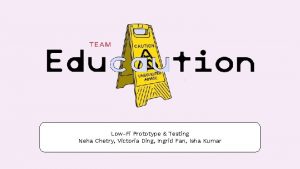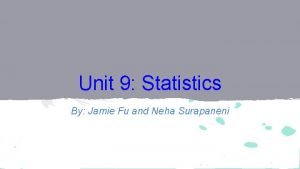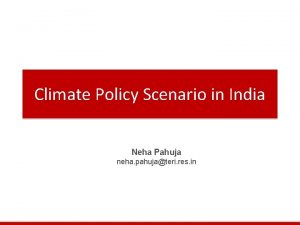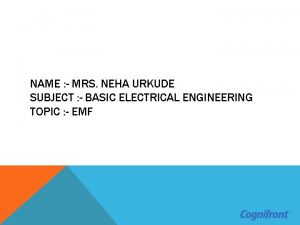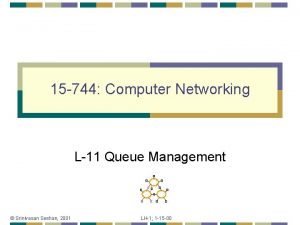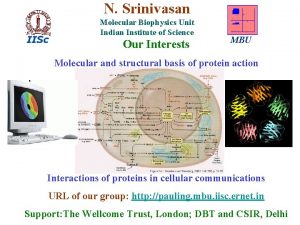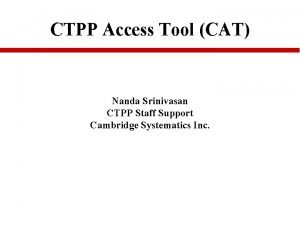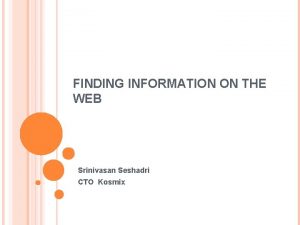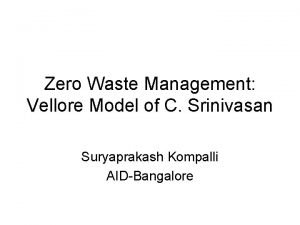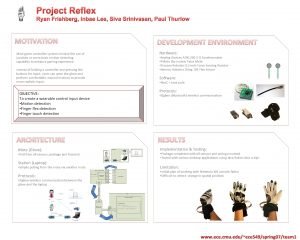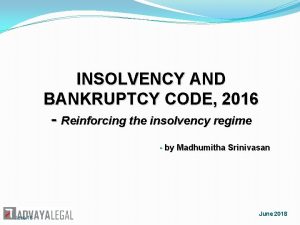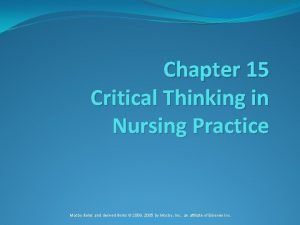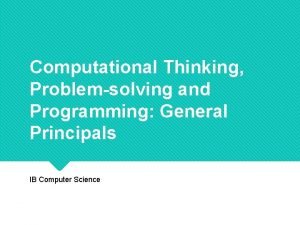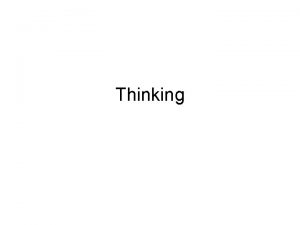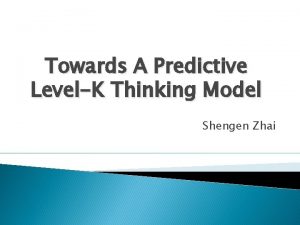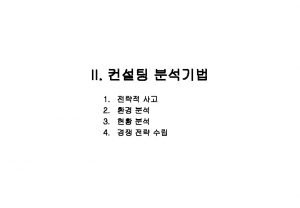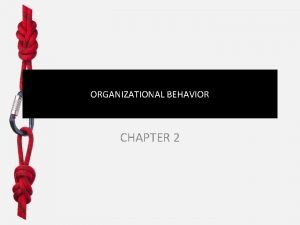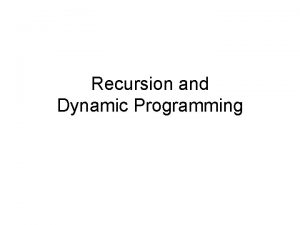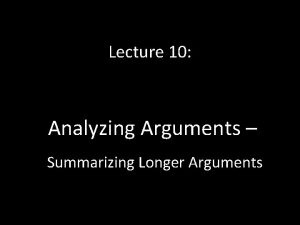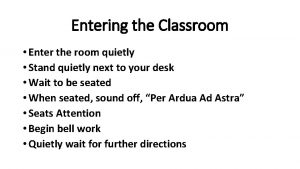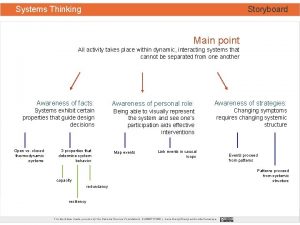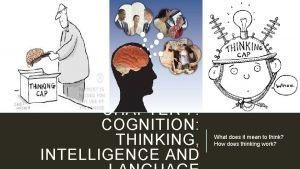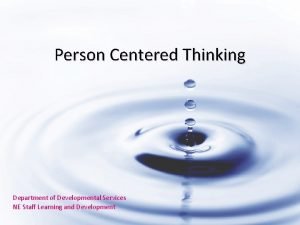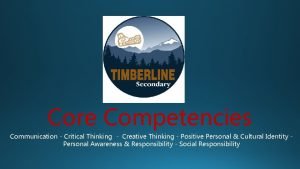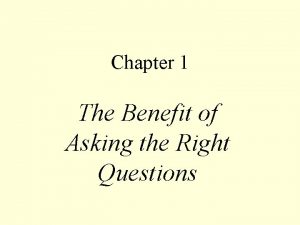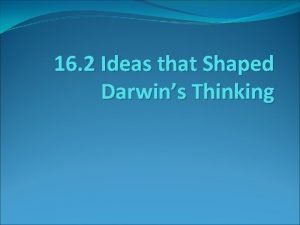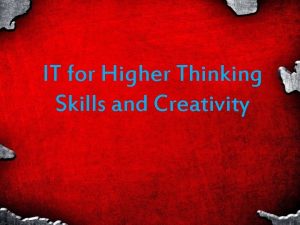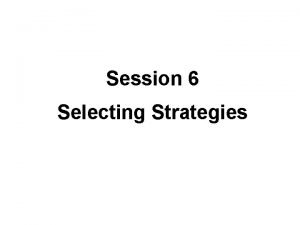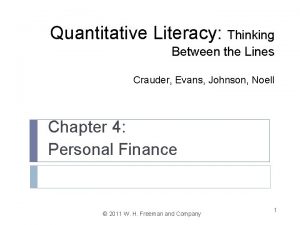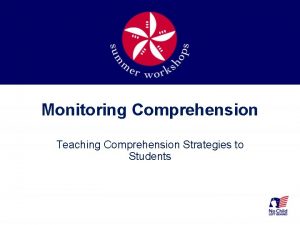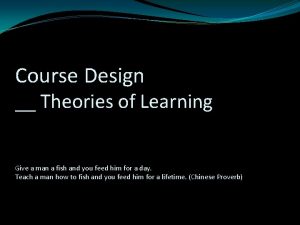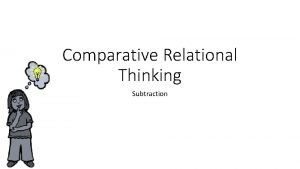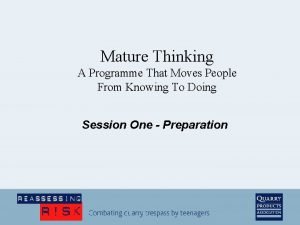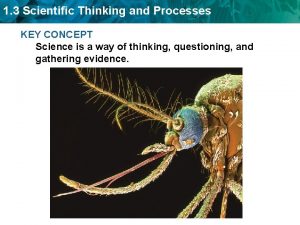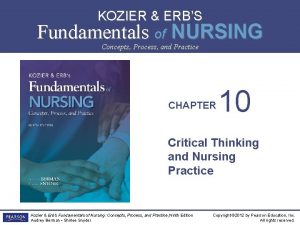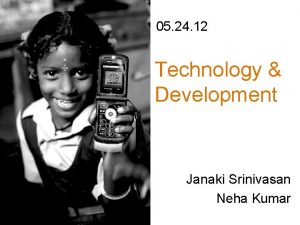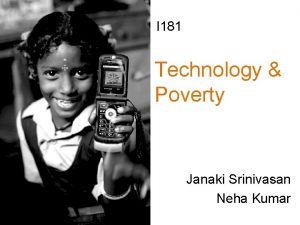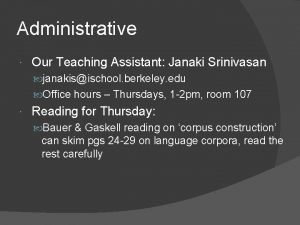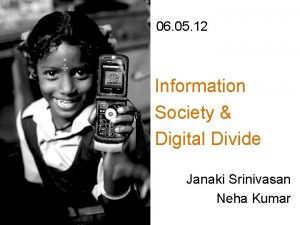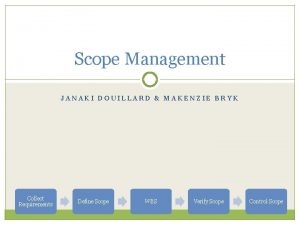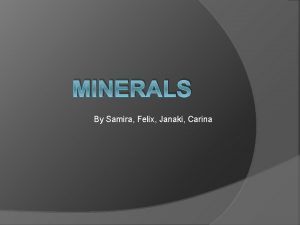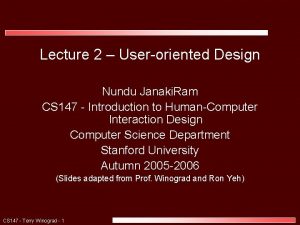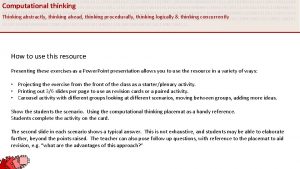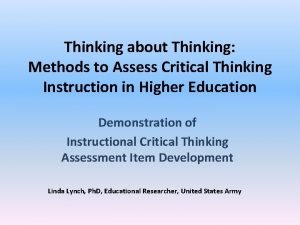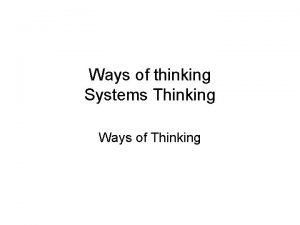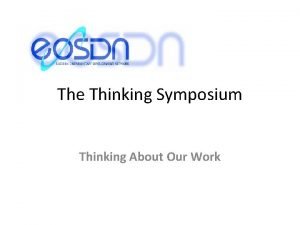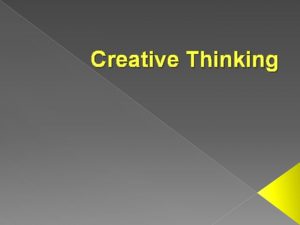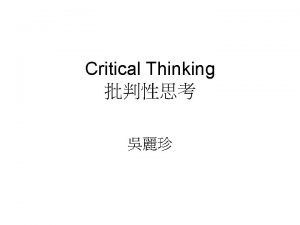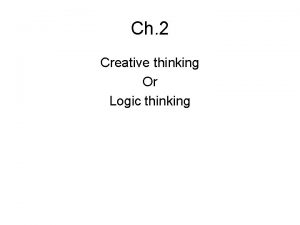05 31 12 Thinking Small Janaki Srinivasan Neha
























![Philosophy to Artifacts • micro-hydro power [Akosombo Dam Capacity: 900 MW] [Micro-Hydro Capacity: ~100 Philosophy to Artifacts • micro-hydro power [Akosombo Dam Capacity: 900 MW] [Micro-Hydro Capacity: ~100](https://slidetodoc.com/presentation_image_h2/9eb3b7865366a6904422545003a6a535/image-25.jpg)


























- Slides: 51

05. 31. 12 Thinking Small Janaki Srinivasan Neha Kumar

On Tuesday (5/29) • Thinking Big – Model – Case of Akosombo Dam – Critiques • Activity: Green Revolution Debate

Administrivia • Due: Reading Response #2 • Back: Reading Response #1 • Join Facebook Group

Outline for Today • Green Revolution (Review) • Appropriate Technology Break • Participatory Development • Social Entrepreneurship • Activity: Discussion of Assignment 1 • Tuesday’s Lecture

Green Revolution: For or Against?

Feedback 1. Define your stance. – Be careful with the T, D, and P words. 2. Credit your sources. 3. Understand causation vs. correlation. 4. See both sides.

Productivity Trends • Productivity did increase in India 10 million tons of wheat (1960) to 73 million tons (2006) • But today productivity gains are slowing down (and at times lagging population growth)

Inputs: Fertilizer and Soil Fertility • More fertilizer needed to produce the same yields as before • Causes: soil erosion and decline in soil fertility

Inputs: Seeds • Bt cotton (2002 – present) a good comparison to earlier 1960 s era Green Rev (focused on food supply – rice & wheat) • Beyond food selfsufficiency: cash crop not a food crop • Introduced without extensive institutional support (ag. extension, institutional loans)

Inputs: Irrigation and Water Supply • Water tables dropping 1 meter per year in Punjab • Boreholes, debt, and suicide • Irrigation also has an impact on soil quality – in some regions leads to salinization or waterlogging

Farmers Enmeshed in Global Markets • …over which they have little control • Seed and input suppliers - rising cost of oil (recently in 2007) means rising cost of fertilizers • Taking out loans to pay for seeds and inputs (sometimes at very high interest rates) leading to debt • National policies change in India - decreasing support for agriculture, decline of institutional loans, subsidies for fertilizers (except urea) are eliminated in 1992

Other Consequences • Pollution from pesticides and fertilizers • Departure of the self-sufficient farm

Modernization Paradigm/ Neoclassical Economic Growth Model Green Revolution Who is doing the development What/Who is being developed Proximate change (short-term) to be brought about The eventual outcome or development to accomplish Mechanism for bringing about this change

Remember these? • Technological Determinism – what is the story that is told about the origins of this artifact/system/process? • Relevant Social Groups – What groups have a stake in the development, diffusion, and use of the technology in question? • Interpretive Flexibility – Are there differences of opinion about whether the technology is ‘working’or not? What priorities, concerns, interests are revealed by these different interpretations? • Closure – Was there a debate about the technology that was resolved? How was it resolved? • Black-boxing – What elements of infrastructure are being overlooked? What are the necessary components to keep this system functional?

Why the Green Revolution? 1. The chance to think about equity 2. Tremendous global impact 3. Enough time has passed

Green Revolution 2. 0 How would you advise today’s efforts to accomplish a new Green Revolution?

The Problem of Scale • Large projects have large-scale impact… • but the unanticipated consequences are also large -scale. • Poor countries depend on foreign partners for necessary resources. • Centralized projects compel mass movement.

1954: “What a stupendous magnificent work – a work which only that nation can take up which has faith and boldness!. . . it has become the symbol of a nation’s will to march forward with strength, determination and courage…As I walked around the [dam] site I thought that these days the biggest temple and mosque and gurdwara is the place where man works for the good of mankind…” 1958: “I have been beginning to think that we are suffering from what we may call ‘disease of giganticism’…We want to show that we can build big dams and do big things…but the idea of having big undertakings and doing big tasks for the sake of showing that we can do big things is not a good outlook at all. ”

Appropriate Technology “What can be done to bring health to economic life outside the big cities, in the small towns and villages which still contain – in most cases – 80 to 90 per cent of the total population? ”

Schumacher critiques… • Forms of work and the effect they have on workers (as facilitated by mechanization) • Emphasis by economists on increased consumption as indication of improved well-being • This leads to competition and overconsumption of natural resources generating small-scale local conflict. • Societies become enmeshed in global markets and large-scale conflict.

A Philosophy of T & D • Technological non-determinism – Can be employed to a multitude of ends (not just boosting productivity) – Can be directed by human interests • Small is Beautiful – “small-scale operations, no matter how numerous, are always less likely to be harmful to the natural environment than large-scale ones…the greatest danger invariably arises from the ruthless application, on a vast scale, of partial knowledge. ”

A Philosophy of T & D Direct vs. Indirect Benefit

Intermediate vs. Appropriate • The term technology has cachet. • Intermediate – Between what and what? • Appropriate supplants “Intermediate” – But what is inappropriate?

How to build an AT Philosophy Rule Self-sufficiency - no dependence Artifacts built and maintained on imports or production of using local materials and skills. exports (to avoid large-scale Capital investment is minimal. conflict) Restrained consumption - no tax Energy efficient, conservationon natural resources (to avoid oriented small-scale conflict) Development in place - bring workplaces to where people are living (rather than moving them) Decentralized, a multitude of small versions rather than one BIG thing People need creative and meaningful work. ? ? ?
![Philosophy to Artifacts microhydro power Akosombo Dam Capacity 900 MW MicroHydro Capacity 100 Philosophy to Artifacts • micro-hydro power [Akosombo Dam Capacity: 900 MW] [Micro-Hydro Capacity: ~100](https://slidetodoc.com/presentation_image_h2/9eb3b7865366a6904422545003a6a535/image-25.jpg)
Philosophy to Artifacts • micro-hydro power [Akosombo Dam Capacity: 900 MW] [Micro-Hydro Capacity: ~100 KW]

Philosophy to Artifacts • Kick. Start NGO • Treadle operated pump pulls water from a well and sprays it out of a hose - for irrigating small farms • 59, 000 pumps in use in Kenya, Tanzania and Mali by 2006

Philosophy to Artifacts • Agriculture and aquaculture: fertilizers, irrigation, crop drying, preservation, storage • Water supply and sanitation: water pumps, water tanks, water filtration and treatment, water reuse, latrines • Energy: improved cookstoves, wind energy, solar energy, biogas • Housing: alternative construction materials

Criticism • Is rural life being romanticized? Is AT motivated by Westerners’ disillusionment with their own modern, urban lives? • Produced for the poor, but not with the poor (participatory approaches emerge separately). • Band-aids for much larger social, structural problems • The challenge of distributing technology was (and is) underestimated. • Does appropriate have to mean “simple? ”

AT Today • See Fisher paper on “Income is Development”. • Business models, fiscal pragmatism, leveraging supply chains • Evaluation and quantification of impact • Not necessarily strict reliance on local materials (self-sufficiency) • Specialized and skilled manufacturing of AT technologies (often in factories)

Sustainable Development • Short-term productivity gains come with rapid depletion of resources that puts future production in jeopardy. • Boosting yields isn’t enough. We must also consider how to manage natural resources to ensure future productivity. • Brundtland Report (1987) stresses the need for sustainable development.

Take a break!

Mainstream Development Models AID REGIME 1950 1960 BASIC NEEDS 1970 STR. ADJ. + WASHINGTON CONSENSUS 1980 1990 • Akosombo Dam (industrial productivity) • Green Revolution (agricultural productivity) NEW INSTITUTIONALISM 2000

Rethinking the Mainstream Models of ‘Doing Development’ • Critiques of the neoclassical growth model/ modernization paradigm – Scale – Environmental degradation – Who defines the problem and the solution? • Alternative frameworks – Appropriate technologies – Sustainable development – People-centered development • Social entrepreneurship?

Rethinking the Mainstream Models of ‘Doing Development’ • Critiques of the neoclassical growth model/ modernization paradigm – Scale – Environmental degradation – Who defines the problem and the solution? • Alternative frameworks – Appropriate technologies – Sustainable development – People-centered development • Social entrepreneurship?

Characterizing Models of Development Other ways of characterizing a model of development: • single vs. multi-dimensional (GDP vs. Millennium Development Goals) • technologically deterministic = technology with direct causality generates economic growth or development • centralized vs. de-centralized • participatory/people-centered = bottom-up, consultative • market-based = improving efficiency of markets or against markets

The ‘object’ of development • National economy (neoclassical economic growth models) • National government and other institutions (new institutionalist approach) ………………. …. . … • Families, households, or individuals (peoplecentered approach)

• Chronology of Bottom-up Approaches From Schumacher – To Chambers ‘Participatory Rural Appraisal’ – To Action Research • ‘Ethnographic Action Research’ on ICTs • Differences – role of researcher vs. ‘subject’ – how is the perspective of the poor engaged? • Commonality – use of qualitative methods

Appropriate Technology (1970 s) • Small is Beautiful as prescription for alternate path of technology development – A pro-poor, bottom-up, direct approach But – makes assertions about the needs of people in developing regions without consulting them

Participatory Development Chambers (1990 s)

Participatory Development Chambers (1990 s) • Data Collection – Emphasis on consultation • “the basic human right of poor people to conduct their own analysis. ” – Data should be shared • rather than extracted

Who Collects the Data? Rapid Rural Appraisal Participatory Rural Appraisal Data collected by outsiders Data collaboratively collected. – ‘handing over the stick’ Data elicited and extracted Data owned and shared locally Information used for external Part of process of researchers agenda ‘empowerment’

What Metrics are Calculated? • In an Institutional perspectives – From single variable definition: • Low per-capita GDP, $1 a day income – To multi-variable definition: • The UN’s Human Development Index (HDI) adds adult literacy and life expectancy to national income statistics in 1990 • Female literacy and mortality added to the HDI in 1991 • Millennium Development Goals – but still the emphasis is on numeric measurement and cross-national comparison

“Whose Reality Counts? ” • How are variations accounted for? – “the realities of poor people are local, complex, diverse and dynamic” • How are priorities set? – “one may speculate on what topics the poor and powerless would commission papers if they could convene conferences and summits” – “what matters most to [the poor] often differs from what outsiders assume, is not always easy to measure, and may not be

Chambers’ Findings: Alternate Priorities • • Social inferiority Isolation Physical Weakness Vulnerability Seasonal Deprivation Powerlessness Humiliation

Alternate Solutions? • Chambers suggests focusing on the priorities set by the poor can yield new and inexpensive ideas for programs/solutions: – Postponing school fee payments (seasonal deprivation) – Training health care staff in ‘customer service’ (social inferiority) – Providing food-for-work to workers who do road repair (during periods of seasonal deprivation)

Emic Accounts and the Sociological Imagination (for Assignment 1!) • Emic accounts = an account from the actor’s point of view. How the poor describe poverty and its causes in their own terms. • Sociological imagination - “to understand the larger historical scene in terms of its meaning for the inner life and the external career of a variety of individuals. ” (Sociologist C. Wright Mills).

Action Research (1970 s and 80 s) • Critique of scholarly research – Not engaged with practice • Action Research – Findings fed immediately into social action Action Research • Agenda of researcher and group being studied must match! See Tacchi, Slater, and Hearn (2003). Ethnographic Action Research, Chapter 3. Action Research and ICTs

Summary of Bottom-up Approaches of ‘Doing’ Development Bottom Consultation Research -up, with the by the poor first Schumacher Chambers – PRA Action Research Actions, solutions by the poor

Back to the Timeline AID REGIME 1950 1960 BASIC NEEDS 1970 STR. ADJ. + WASHINGTON CONSENSUS 1980 1990 NEW INSTITUTIONALISM 2000 Social Entrepreneurship?

Your first assignment Step 1. Form groups of 4 people – pick a book (excerpts on email): • Factory Girls: From Village to City in a Changing China, Leslie T. Chang • Crossing Over: A Mexican Family on the Migrant Trail, Ruben Martinez • Kaffir Boy: The True Story of a Black Youth’s Coming of Age in Apartheid South Africa, Mark Mathabane • Death Without Weeping: The Violence of Everyday Life in Brazil, Nancy Scheper-Hughes

On Tuesday (6/5) • Lecture: “Digital Divide and Information Society” – Diverse meanings of terms • Due before class – Do the readings: Webster, Keniston – Try to think of ideas about the digital divide in the models of technology and development that we have talked about • Activity in class – We will head to Sproul Plaza for an observation exercise!
 Biomedical waste management introduction
Biomedical waste management introduction Victoria ding
Victoria ding Neha surapaneni
Neha surapaneni Neha premkumar
Neha premkumar Neha pahuja
Neha pahuja Neha urkude
Neha urkude Dr k srinivasan
Dr k srinivasan Srinivasan seshan
Srinivasan seshan N srinivasan iisc
N srinivasan iisc Sharadha srinivasan
Sharadha srinivasan Nanda srinivasan
Nanda srinivasan Srinivasan seshadri
Srinivasan seshadri Vellore srinivasan waste management
Vellore srinivasan waste management Siva srinivasan
Siva srinivasan Avaya wos
Avaya wos Sathish srinivasan
Sathish srinivasan Madhumitha srinivasan
Madhumitha srinivasan Holistic judgement
Holistic judgement Perbedaan critical thinking dan creative thinking
Perbedaan critical thinking dan creative thinking Positive thinking vs negative thinking examples
Positive thinking vs negative thinking examples Thinking about you thinking about me
Thinking about you thinking about me Thinking about your own thinking
Thinking about your own thinking Fundamentals of nursing chapter 15 critical thinking
Fundamentals of nursing chapter 15 critical thinking Thinking procedurally computer science
Thinking procedurally computer science Conjunctive thinking
Conjunctive thinking Level k thinking
Level k thinking Hots questions examples
Hots questions examples Market activated corporate strategy framework
Market activated corporate strategy framework Are abstract ideals that guide one's thinking
Are abstract ideals that guide one's thinking Recursive thought
Recursive thought Standardizing arguments critical thinking
Standardizing arguments critical thinking She entered into the room quietly
She entered into the room quietly Systems thinking tools
Systems thinking tools Chapter 7 quiz cognition thinking intelligence and language
Chapter 7 quiz cognition thinking intelligence and language Positive attitude introduction
Positive attitude introduction You can all come to my party
You can all come to my party Thinking person
Thinking person Stuntnastics
Stuntnastics Social traps ap psychology definition
Social traps ap psychology definition Weak sense critical thinking
Weak sense critical thinking 15-2 ideas that shaped darwin's thinking
15-2 ideas that shaped darwin's thinking Guided hypermedia projects
Guided hypermedia projects Comprehensive thinking
Comprehensive thinking Quantitative literacy thinking between the lines
Quantitative literacy thinking between the lines Monitoring comprehension strategies
Monitoring comprehension strategies Eku compass
Eku compass Think out of the paradox
Think out of the paradox Mentalism thinking as rule-governed activity
Mentalism thinking as rule-governed activity Relational algebra subtraction
Relational algebra subtraction Mature thinking
Mature thinking Section 3 scientific thinking and processes
Section 3 scientific thinking and processes Nursing inferences examples
Nursing inferences examples

